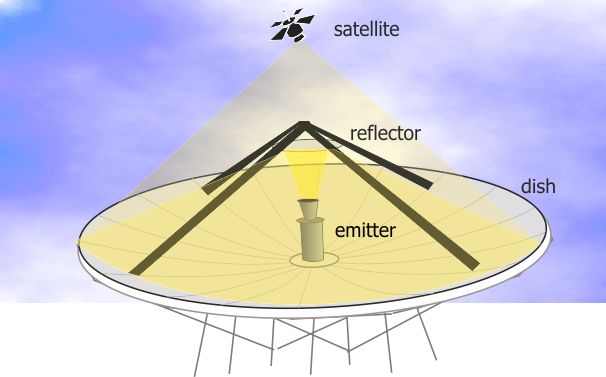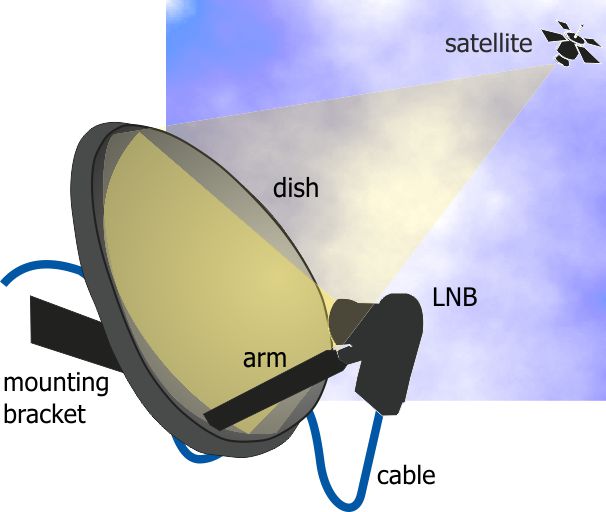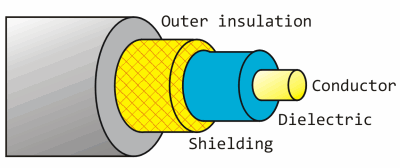Freesat reception - all about dishes
 Brian Butterworth published on UK Free TV
Brian Butterworth published on UK Free TV Satellite reception has both advantages and disadvantages compare with terrestrial (aerial) reception.
By using much higher frequencies (gigahertz, compared to terrestrial televisions megahertz) more transmission channels called transponders (the satellite equivalent of multiplexes) can be provided. For example, there are only six Freeview multiplexes, but Sky or Freesat users can access two hundred satellite transponders.
Aside from exceptional weather conditions (very heavy rain for example) digital satellite provides stable pictures and audio. Where Freeview transmitters are no more than 732 metres above sea level, the geostationary satellites used for television are 35,800,000 metres above the equator so reception is possible even where buildings, trees and hills make terrestrial reception impossible.

The downside of the transmitters being 22,300 miles up in the air is that the signals are very, very weak - so standard TV aerial is of little use. When the signals are sent to the satellites, huge dish transmitters are used to uplink the signal to the satellite. These are tens of metres from side to side, and feature an emitter that generates the signal, which is first bounced of a mirror (called a reflector) and then off the surface of the parabolic dish.

There are many satellites in the sky over the equator. Often these are in clusters over a particular position, for example there are four used for UK television are at 28.2 degrees east. There is another cluster over the 19.2 degrees east positions that are used for German television.
To receive these very weak signals from the satellite, it is necessary to use a dish for reception too. By using a reflective dish, this concentrates the signals onto a small device called a LNB. This is held in front of the dish by a metal arm.

The size of dish for reception is typically much smaller; often 60cm to 100cm in diameter, but the exact size depends upon the transmitting satellite transponder. To keep the transmission power levels down to levels that can be powered by the satellite's solar panels, each beam is focused on a particular area of the Earth's surface. If you are trying to receive the signal at the centre of this zone, a small dish is required. At the outer edges, you may need a 5 metre dish. Maps of these zones are provided by the satellite companies, and are called satellite footprints.
When the dish is installed it must be aligned carefully as the signal is very weak. The installer needs to know the inclination and the azimuth from the ground location to the satellite. If you install yourself you will find that there are markings on the dish that are used to point the dish in the correct position. It is important that the view of the satellite will not be blocked, so must take into account leaves growing on trees and potential building works.
For many people the LNB will have a single cable connected to it, however if you have Sky+ or a multi-room installation the LNB package will actually contain four receivers a quad-LNB. Unlike terrestrial television where you can split the aerial cable to feed more than one Freeview box or television set, with satelite reception you cannot. So, a Sky+ box with two receivers (so you can watch one thing and record another) has two cables connecting the box to the dish.
The cable that connects the dish to the receiver must be satellite grade cable. Whilst this looks superficially like the cable used to connect and aerial to a television, a higher grade cable is required for satellite reception.
Here is an image of a co-axial cable. This sort of cable is used to connect any type of receiving aerial to the reception equipment.

RG6, PF100 and PH100 are all types of coax cable that are suitable for the very weak signals that are received by a satellite dish. (The power is the same as you would receive from a one-bar electric heater on the moon).
The conductor in the centre passes the signals received from the dish to the set-top box. This is made from steel in RG6 cable, and from copper in the RF100 and PH100 types. This makes RG6 less suitable in the UK where rain can damage the cable.
The shielding is responsible for keeping unwanted external interference from damaging the signal. In the cheaper cable this will be a foil wrap, in better specified cables this is a braid (or mesh) of copper wires. The sheild in the RF100 covers 58% of the cable.
The non-conducting layer between the shield and the conductor is called the dielectric. This can be either a solid (RG6), foam (RF100) or air-spaced (PH100) dielectric. This makes the cables progressively more flexible (ie bendy without damage).
10:11 AM
Hi, I am new to freesat, I have an old Sky dish (about 15 years old) and got myself a Humax freesat box, tuned it in and its great most of the time, signal and quality strength is good, but sometimes I loose signal. Today the weather is fine just a very light breeze and this morning it was impossible to watch for about 2 hours but is perfect again now. it does this every now and again, not always in bad weather, do I need a new dish do you think?
| link to this comment |
7:22 PM
Susan Wheatley:
No you do not need a new dish, but you may need to have the cables and LNB checked. The dish is merely a reflective curved surface to focus the signals from the satellites onto the LNB, the small block on the outer end of the arm at the front of the dish. The LNB receives the signals so reflected and converts them to be suitable for carrying via the downleads to feed into the receiver.
It is possible that the LNB may be developing a fault after so many years and it is also possible that the cable(s) have deteriorated over the years as they are so exposed to the weather.
| link to this comment |
11:13 PM
MikeP: Thanks for that, can I check the LNB and cables myself (well not me my other half) or is it a job for an engineer?
| link to this comment |
7:30 PM
Susan Wheatley:
If your 'other half' is skilled at electrical work and is happy climbing ladders to the roof and knows about the type of connectors used then he may be able to do it himself. Personally, if he can't say yes to all of those I would strongly recommend a good aerial/satellite installer be asked to do the work for you.
| link to this comment |
1:45 AM
Susan I am SHOCKED by the gender stereotyping inherent in your assignation of such work to a male companion.
Looking for damage/dirt and wabbling connections or plugcycling are well within the capabilities of the gentler gender.
Obviously anything more advanced will need male skills though.
| link to this comment |
7:35 PM
steve P:
If that is the way she wants to express herself than that is fine by me. I would say exactly the same if it were the other way round.
| link to this comment |
5:01 PM
What is the difference between a zone one and two satelitte dish for my new freesat please . Thank you .
| link to this comment |
5:08 PM
David Rowlands: They are different sizes. Which size you need will depend on how far north you are.
| link to this comment |
5:49 PM
Thank you for your reply . I live in Ivybridge which is in the south hams in Devon . Can you please advise me what size of dish would be best please . Thank you ..
| link to this comment |
6:55 PM
David Rowlands: A small dish (e.g. 40cm) would be fine anywhere near the south coast.
| link to this comment |